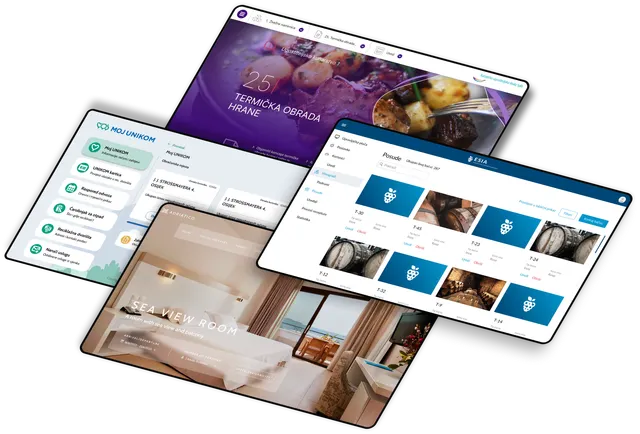
AI in Agriculture: The Most Impressive Use Cases and Benefits Yet
Key takeawaysThe AI in agriculture market is expected to ...

Author:
Ana Lozančić

You might be an owner of a brick-and-mortar store or an entrepreneur looking to start an E-commerce business, or just want to know more about e-commerce website development – in any case, you are in the right place.
Year after year, online shopping is becoming more commonplace. That trend is visible in the numbers too.
According to Statista, online market made up 14% of all sales, predicting to rise to almost 20% by the year 2028. With the trends on a rise, why not embrace online retail and stay ahead of the curve?
Let's explore the best way to make an e-commerce website that stands out in the modern online marketplace.
So, you have decided to open an online store and now you might be wondering what are all the necessary steps to create an e-commerce website. Let us go over the whole process step by step!
Step 1. Define your goals
Before diving into development, clearly outline your business goals, target audience, and specific requirements for the e-commerce website. Understand your needs and wants to achieve your goals.
Step 2. Market research
Research your target market, competitors, and industry trends. Identify your unique selling propositions (USP), define your business model (B2C, B2B, C2C, or C2B), and consider your shipping methods.

Step 3. Choose a suitable E-commerce platform
Once you know what you are looking for, you should choose a platform that suits your needs. You could choose one of the cookie-cutter services such as Shopify or WooCommerce, or you can opt out for a more custom service like Gauss Box E-commerce platform that can help in every step of creating your e-commerce website.
Step 4. Choose a domain name
Make sure that the whole website reflects your brand, including the name. Choose something memorable and unique.
Step 5. Design the website
Invest in a user-friendly and appealing design done by seasoned UX and UI design professionals based on your e-commerce website design ideas. In that way, you can be confident your website is easily navigated on all devices while staying true to your brand.
Step 6. Product catalog setup
Make sure to organize your products into categories and ensure that each product has a search-friendly name, a detailed description, and high-quality images for e-commerce website use.
Step 7. Shopping cart and checkout
Define all the necessary steps from adding to cart to checkout, making the process streamlined and simple.
Step 8. Payment gateways and security measures
Make sure to choose reliable payment gateways and that your website follows the latest security protocols to provide customers with a seamless and trustworthy online shopping experience.
Step 9. Analytics implementation and SEO
Integrating analytic tools allows you to make better business decisions while SEO improves your site visibility and increases customer numbers.
Step 10. QA and testing
Before launch and during the whole development process, any website should undergo QA and testing especially if it’s an E-commerce platform.
Step 11. Launch and marketing
After the site has been crafted and tested it is time to launch it with a prepared marketing strategy that will drive traffic to your webshop.
Now that you have a better grasp on how to create a dynamic ecommerce website and how the general process works, let us go into more detail when it comes to features and software requirements.
E-commerce websites come in many different designs with varying features and customer journeys.
Despite the differences, you may have noticed certain features that almost all webshops have and the ones that don’t, should. These common features ensure that any customer can easily find what they want, add it to the cart, process their payment, and have it delivered as soon as possible.
The question is what features create a satisfying user experience in online shopping?
1. Responsive website design
Users love well designed and responsive websites. Recent trends have shown a rise in online purchases over the phone where the mobile share of e-commerce saleshas reached 60%. Taking that into account, the website needs to be responsive on both mobile and desktop.
2. User-friendly navigation
According to the Digital Experience Benchmark, users across the board are spending less time on websites and leave in a less than a minute. In that short amount of time, retail visitors click on product and category pages 60% of the time, followed by the homepage and search page. Making sure your customers can reach what they want in the shortest amount of time means great on-site navigation.

3. Quick log in options
Quick account creation either using an email or other accounts such as Gmail, Facebook and similar will ensure your customers do not give up if they need an account to complete a purchase.
4. Fast and simple shopping cart and checkout
Customers want to easily add their items to a shopping cart, review their products, and proceed to payment options. The shorter and simpler this process is, the less likely it is for customers to finish the purchase.
5. Various payment options
Imagine a customer adding various items to their cart, arriving to the checkout and seeing that their preferred payment options are not available – they will most likely just abandon their cart. In the world of rising investments and customer acquisition costs it is important to not only gain a customer, but to retain it.
60% increase in customer acquisition costs from 2017 to 2022. Today, ecommerce brands lose an average of $29 for every new customer acquired. The only sustainable way to combat this rising CAC is to lean into customer retention. (Businesswire)
6. Clear shipping and return information
Clearly communicating shipping costs to your customers makes purchases more likely and decreases cart abandonment rates. Importance or return policy information is shown in the numbers, where 86% of customers consider the return policy before purchase.
7. Crystal clear photos and videos
Do not underestimate the value of sharp product images. Despite the fact that almost 88% of ecommerce shoppers agree that clear product images are crucial for their shopping experience, many websites still use one or two grainy images for their products. You can easily gain advantage over competition with high-quality visuals.
8. Easy customer communication
Provide your customers with multiple channels of communication so they may reach out to you if they have questions, concerns, or feedback. Consider expanding your contact page beyond just an email address; add a contact form, live chat or any other means of communication that suits you.
By now you must be wondering what technologies are needed to build an e-commerce website and probably think there must be an exhaustive list. Well, you’ll be glad to know that you mostly need a good and reliable content management system (CMS).
Using CMS software, you can easily manage most aspects of running an e-commerce website. From updating product listings and managing inventory to setting up payment gateways, processing orders, and analyzing your sales; you can easily set up and manage your online store.
Using such specialized software saves you time and allows you to make data-driven business decisions.
The pressing question now may be “How much does it cost to build an e-commerce website?” or “How much does it cost to start an e-commerce website?”. The answer to that question is, well, it depends.
There are many factors to consider that add to the price, such as the choice of platform, feature complexity, design intricacies, and the degree of customization.
When considering cost, it is essential to view it as an investment in your online business. There is also something to be said about template vs custom web development where a custom solution might be more costly but can lead to greater returns in the long run.
If you are interested in a template e-commerce website or a custom webshop design with added features, you can reach out to us and we will gladly help make your online store dream into reality.
If you have a small business and wish to take advantage of online commerce, why not invest in an e-commerce website?
With so many tools and platforms, building a small webshop has never been easier. Following the steps we have lined out in the What are the steps to design and develop an e-commerce website chapter, you can have your business up and running in no time.
But there are a few specifics of a small online store you should keep in mind.
As a small business, you will be dealing with individual customers, small volume orders from a straightforward product catalogue with standard pricing. Your goal is to find your niche and make sure to provide your customers a simple and hassle-free buying process.
If your goal is to make a larger online store that targets businesses, you follow all the same basic steps, while keeping in mind the specifics of B2B commerce.
Since you target businesses and wholesale buyers, your product catalogue should reflect that, especially in tiered pricing, bulk ordering, custom quotes, and negotiation tools. Also, you should be mindful of legal compliance and security measures since you will handle and process sensitive business information.
One more recommendation is to invest in an ERP system solution that integrates e-commerce with the rest of your business activities, making it easier to build a thriving online store.
With the right strategy and execution, your E-commerce website can become a valuable asset to your business.
If you have any further questions or need assistance with your e-commerce development journey, feel free to reach out to us. We're here to help you succeed.

